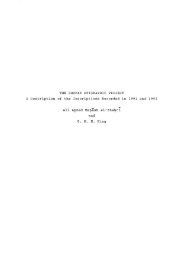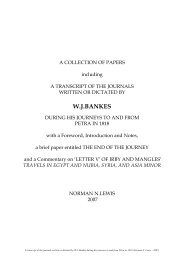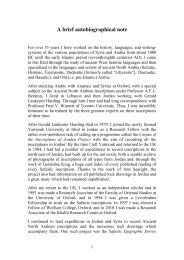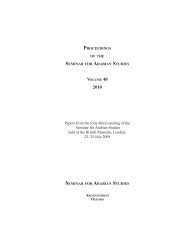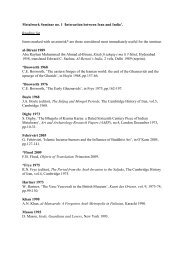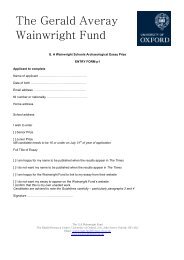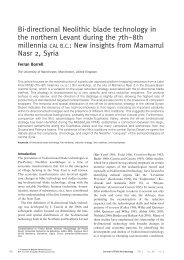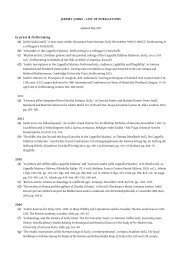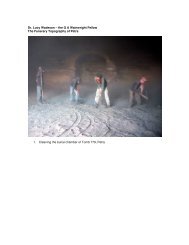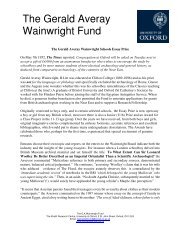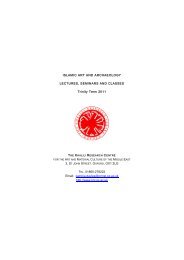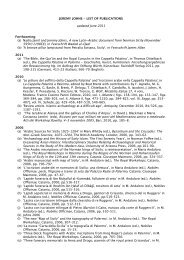W. J. Bankes and the Identification of the Nabataean Script - Khalili ...
W. J. Bankes and the Identification of the Nabataean Script - Khalili ...
W. J. Bankes and the Identification of the Nabataean Script - Khalili ...
Create successful ePaper yourself
Turn your PDF publications into a flip-book with our unique Google optimized e-Paper software.
42 N.N. LEWIS <strong>and</strong> M.C.A. MACDONALD<br />
Syria 80 (2003)<br />
THE NABATAEAN SCRIPT<br />
DISCOVERY, IDENTIFICATION AND DECIPHERMENT 1<br />
The existence in Sinai <strong>of</strong> rock-cut writings in a strange script has been known in <strong>the</strong> Christian world since<br />
at least <strong>the</strong> early sixth century AD, when an Alex<strong>and</strong>rian merchant, later known as Cosmas Indicopleustes,<br />
noticed <strong>the</strong>m while travelling through Sinai. 2 He tried to discover what <strong>the</strong>y were <strong>and</strong> what <strong>the</strong>y said, <strong>and</strong> some<br />
Jews who claimed to be able to read <strong>the</strong>m told him that <strong>the</strong>y recorded > Cosmas speculated that <strong>the</strong> Children <strong>of</strong> Israel<br />
first learnt <strong>the</strong> art <strong>of</strong> writing after Moses received <strong>the</strong> Law on Mount Sinai <strong>and</strong> inscribed it on tablets <strong>of</strong> stone.<br />
Thus, he reasoned, writing was given by God to <strong>the</strong> Israelites at a very early period in <strong>the</strong>ir history <strong>and</strong>, during<br />
<strong>the</strong>ir forty years w<strong>and</strong>ering in <strong>the</strong> Wilderness, <strong>the</strong>y practised it with exuberance on <strong>the</strong> rocks <strong>of</strong> <strong>the</strong> Sinai desert. 3<br />
Cosmas went on to suggest that, after <strong>the</strong>ir entry into <strong>the</strong> Promised L<strong>and</strong>, <strong>the</strong> Israelites passed <strong>the</strong> script to <strong>the</strong>ir<br />
neighbours, <strong>the</strong> Phoenicians, who, via Cadmus king <strong>of</strong> Tyre, transmitted it to <strong>the</strong> Greeks <strong>and</strong> <strong>the</strong>nce to <strong>the</strong> rest<br />
<strong>of</strong> <strong>the</strong> world.<br />
Although it was incorrect, this <strong>the</strong>ory had a certain internal coherence <strong>and</strong> was immensely attractive in that<br />
it promised access through <strong>the</strong>se texts to a primeval writing system, given directly by God to Man on Mount<br />
Sinai, from which every alphabet in <strong>the</strong> world could trace its ancestry.<br />
The first printed edition <strong>of</strong> Cosmas' work was published in Paris in 1706 4 <strong>and</strong> it was not long before his <strong>the</strong>ory<br />
became <strong>the</strong> orthodox view, ousting more recent hypo<strong>the</strong>ses 5 <strong>and</strong> generating considerable interest in <strong>the</strong><br />
> inscriptions throughout Europe. Thus, in 1753 Richard Clayton, Bishop <strong>of</strong> Clogher, published an<br />
English translation <strong>of</strong> <strong>the</strong> journal <strong>of</strong> <strong>the</strong> « Prefetto >> <strong>of</strong> <strong>the</strong> Franciscans at Cairo. The Prefetto had noticed <strong>the</strong><br />
inscriptions on his way to <strong>the</strong> monastery <strong>of</strong> St. Ca<strong>the</strong>rine in 1722 <strong>and</strong> remarked that < though we had in our<br />
company persons, who were acquainted with <strong>the</strong> Arabic, Greek, Hebrew, Syriac, Coptic, Latin, Armenian,<br />
Turkish, English, Illyrican, German, <strong>and</strong> Bohemian languages, yet none <strong>of</strong> <strong>the</strong>m had any knowledge <strong>of</strong> <strong>the</strong>se<br />
characters >. 6 Clayton's commentary is an (unacknowledged) expansion <strong>of</strong> Cosmas' <strong>the</strong>ory:<br />
1. The authors are grateful to <strong>the</strong> National Trust <strong>and</strong> to <strong>the</strong> Dorset Archives Service for giving <strong>the</strong>m access to <strong>the</strong> material discussed<br />
here <strong>and</strong> for permitting <strong>the</strong>m to publish it. References below in <strong>the</strong> form D/BKL HJ4/12 >> are to <strong>the</strong> W.J. <strong>Bankes</strong> Travel Journals<br />
Collection in <strong>the</strong> Archive <strong>of</strong> <strong>the</strong> <strong>Bankes</strong> Family <strong>of</strong>Lingston Lacy <strong>and</strong> Corfe Castle, held by Dorset Record Office at Dorchester <strong>and</strong> owned<br />
by <strong>the</strong> National Trust. Those in <strong>the</strong> form < D/BKL V.A 21 >> are to <strong>the</strong> W.J. <strong>Bankes</strong> Drawings <strong>and</strong> Inscriptions Collection in <strong>the</strong> same<br />
archive. We would also like to thank Madame Pascale Linant de Bellefonds for providing us with a number <strong>of</strong> excerpts from <strong>the</strong><br />
unpublished manuscript logbook kept by Linant de Bellefonds on his journey with Leon de Laborde, <strong>and</strong> Dr Lafla Nehme for alerting<br />
us to many <strong>Nabataean</strong> references. Unless o<strong>the</strong>rwise stated, translations from works in languages o<strong>the</strong>r than English are by Macdonald.<br />
2. COSMAS INDICOPLEUSTES/MIGNE 1864: Liber V. §§205-206, col. 215-218.<br />
3. < Those who have newly acquired <strong>the</strong> art <strong>of</strong> writing write frequently <strong>and</strong> much; <strong>and</strong> thus it is that all <strong>the</strong>se places [in Sinai] are<br />
covered with Hebrew inscriptions. > COSMAS INDICOPLEUSTES/MIGNE 1864: §205, col. 217.<br />
4. MONTFAUCON 1706.<br />
5. For instance, an early seventeenth-century traveller records that both <strong>the</strong> monks at St. Ca<strong>the</strong>rine's monastery <strong>and</strong> <strong>the</strong> Bedouin who<br />
guided pilgrims to it, repeated a tradition that one text on a stone at <strong>the</strong> foot <strong>of</strong> Mount Sinai had been written by <strong>the</strong> Prophet Jeremiah<br />
to mark <strong>the</strong> place where he had hidden <strong>the</strong> < sacred vessels >> from <strong>the</strong> Temple (II Maccabees 2: 4-6), despite <strong>the</strong> fact that <strong>the</strong> Biblical<br />
passage quite clearly refers to Mount Nebo, not Mount Sinai (see KIRCHER 1636: 205), a point reiterated by Pococke when he saw <strong>the</strong><br />
remains <strong>of</strong> <strong>the</strong> inscription more than a century later (POCOCKE 1743-1745, I : 148). Kircher, who published a copy <strong>and</strong> tentative<br />
decipherment <strong>of</strong> this inscription [= CIS II 3031 ] believed that it was a very ancient < Chaldaic >> inscription <strong>and</strong> interpreted it as an echo<br />
<strong>of</strong> Isaiah's prophecy o Behold a virgin shall conceive... >> (Isaiah 7:14; see KIRCHER 1636: 206-216), though he believed that <strong>the</strong>re were<br />
many o<strong>the</strong>rs in <strong>the</strong> < ancient Hebrew character >> around <strong>the</strong> area where Moses had broken <strong>the</strong> tablets <strong>of</strong> <strong>the</strong> Law. The French traveller,<br />
de Monconys, who passed through Sinai in 1647, <strong>and</strong> whose Bedouin guides denied him <strong>the</strong> opportunity <strong>of</strong> copying <strong>the</strong> texts, recognized<br />
that <strong>the</strong> letters had < ni la forme des Latins, Grecs, Hebreux, Arabes, ni des Hieroglyphiques >> but never<strong>the</strong>less concluded that



